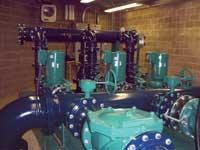To provide 24/7 storage for residential service at both higher and lower elevations, as well as industrial fire suppression up to 2400 gpm @72 psi for three hours, engineers specified that a three-pump booster station be installed within the base of the new storage tank.
Click here to enlarge imageThe Brownsburg system serves about 7600 metered customers, 85% residential and the rest business, commercial and industrial. Peak daily consumption is 2.8 mgd, with the average at 1.6 mgd. The town’s two water plants provide a total of 1,725 gpm and an additional 575 gpm is purchased.
Previously, the system relied only on a 120’ hydropillar storage tank to provide 56 psi at peak demand. But by 2003, with demand growing in higher elevations of the northern area, typical pressure had lowered to 38-42 psi. In new two-story homes, some with as many as five baths, upstairs pressure was as low as 32-34 psi. Meanwhile, an industrial park that had started in 2001 required fire flow capability of 1,800-2,200 gpm @ 20 psi min., and it was not yet half built out.
“We began to be concerned about approaching the 20 psi minimum mandated by the Indiana Deptartment of Environmental Management,” Servies said. “We increased our main sizes from 6", 8" and 10" to 12", 16" and 20", and now needed to isolate eight main feed valves to allow for steady 56 psi for the southern part of the service area, and also decided we needed a boost to 72 psi for the northern demand to create capability for the fire flows potentially needed there. We needed enough capacity for the largest building in the park and still provide for residential needs if we had to deploy it. Increasing our purchased flow wasn’t going to help enough.”
In response to the challenge of providing 24/7 storage need for residential service as well as fire suppression up to 2,400 gpm @ 72 psi for three hours, Curry & Associates specified a three-pump booster station, including in-line variable frequency drives (VFDs), to be installed within the base of a new storage tank in the north end of the service area that matched the height of the existing tank in the south.
Bob Curry, the engineering firm’s president, said a key feature of the booster station was its pre-assembled, pre-programmed, calibrated and tested automatic controls.





